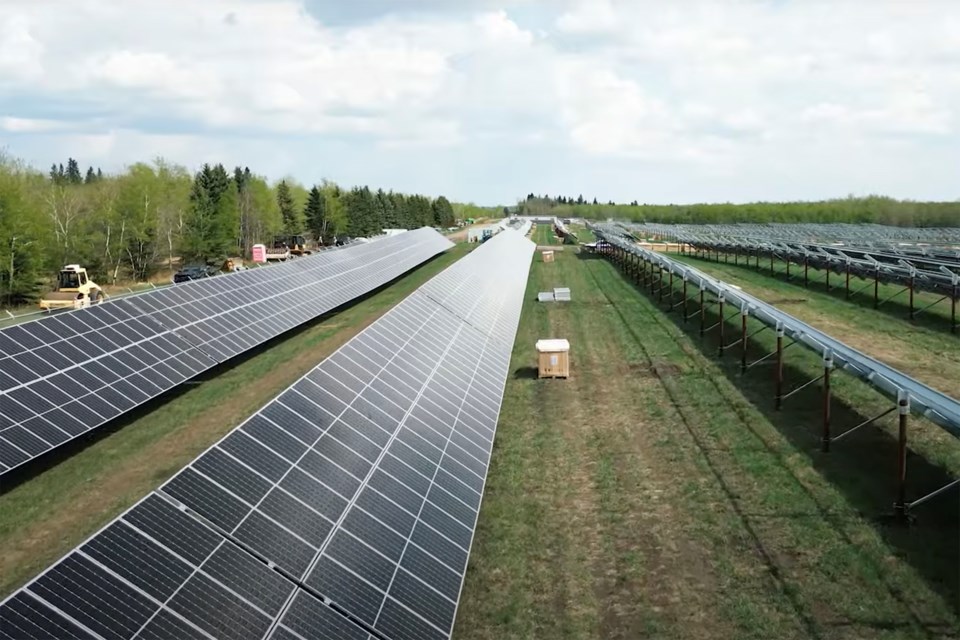LAKELAND - Construction of the Métis Crossing Solar Project, recently renamed Salay Prayzaan, which began in 2022, is expected to wrap up this fall.
Salay Prayzaan, which is Michif for “a gift from the sun,” is a 4.86-megawatt community generation solar plant consisting of 12,840 panels being built near the Métis cultural site south of Smoky Lake. The project has been constructed by the Métis Nation of Alberta (MNA), which, following the recent election for the first-ever Otipemisiwak Métis Government in Alberta, will soon be re-branded.
According to Andres Filella, Director of Climate Environment and Climate Change for the MNA, the plant will generate enough electricity to power 1,200 homes and offset energy generated by other sources, which in turn will result in the reduction of greenhouse gas (GHG) emissions of approximately 4,700 tonnes of CO2 equivalent in the first year of operation.
The energy generated by the solar modules, he continued, will be fed back onto the local distribution grid, where it will flow to the nearby community, which includes Métis Crossing and Smoky Lake County.
Sharing the sun
“Revenue generated by Salay Prayzaan will benefit all partnering communities. MNA revenues will fund social, environment and economic initiatives for the benefit of Alberta Métis,” he said, adding that Smoky Lake community will see significant tax revenue from the project. “The MNA, in partnership with the Town of Smoky Lake, has committed to a Community Development Fund from the project revenues to fund projects that benefit the local community.”
Salay Prayzaan is located on 30 acres at the north end of Métis Crossing and has been designed to fit in with ongoing development of the site.
“Since its inception, Métis Crossing has been fully incorporated to align with the solar project, including the site’s motto of the site’s Interpretive Strategy — Métis Crossing: Our Past, Our Present, Our Future,” said Filella.
Construction of the Salay Prayzaan project was a major undertaking requiring input from many stakeholders to ensure the project would be successful. Pre-project development work included assessments of land availability, utility interconnection options, desktop environmental reviews, project economics, risk, and community benefits.
At its peak, the construction phase employed 10 full-time workers, along with dozens of other contractors. The project is said to have brought upwards of $12 million in economic spin-off to the Smoky Lake area.
Fighting climate change
MNA Citizens first directed the MNA to act on climate change via the Climate Change Action Plan, which was passed unanimously at the 89th MNA Annual General Assembly in Peace River in 2017. Since then, the MNA has installed micro-generation solar projects at 37 sites totalling 530 kilowatts of capacity — or about 10 per cent of the Salay Prayzaan capacity.
“These solar installations have resulted in significant savings on utility bills for the sites,” he said. “Salay Prayzaan will be the largest wholly Métis-owned solar project in Alberta and is a key initiative of the Métis Nation of Alberta (MNA) Climate Change Action Plan.”
The Metis Crossing project is believed to be the largest, single solar generation plant created by a Métis group.
Salay Prayzaan will lay the foundation for the future in prioritizing innovative and sustainable energy sources,” said Filella. “The MNA will continue to take the initiative to ensure that a sustainable way of living is fostered for generations to come.”
Environmental and economic benefits
Salay Prayzaan will also play a role in diversifying electricity generation in the province, said Filella, adding that in 2022, 64 per cent of Alberta’s electricity came from gas, 17 per cent from coal, and 17 per cent coming from renewable sources.
“Salay Prayzaan will help diversify Alberta’s electricity generation by increasing the available generation of renewable electricity,” he stated. “Salay Prayzaan will serve as an example of Métis leadership in renewables, and a model for communities considering community generation.”
The deep and longstanding connection between Métis people and the land is an important part of Métis history and culture.
“For hundreds of years, Métis people have been stewards of the environment, often combining traditional environmental knowledge of the lands they inhabit with entrepreneurial economies,” Filella explained. “The establishment of this infrastructure in the MNA community will lay the foundation for the future in prioritizing innovative and sustainable energy sources. The MNA will continue to take the initiative to ensure that a sustainable way of living is fostered for generations to come.”



